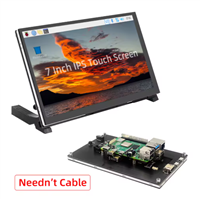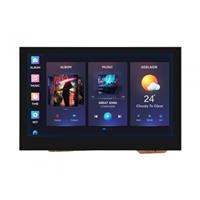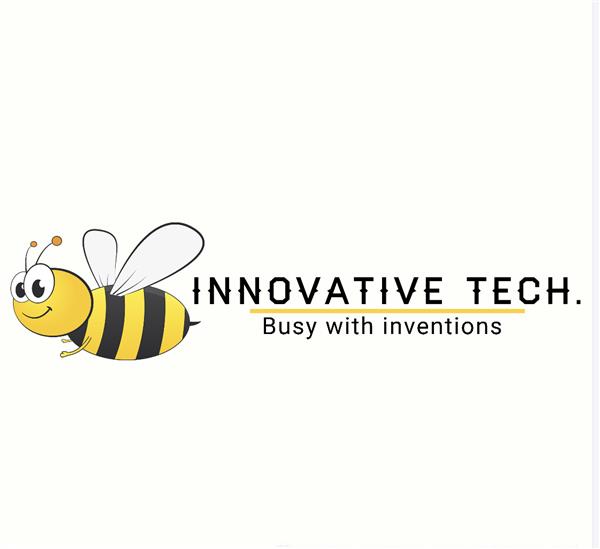
|
Autodesk Fusion 360Autodesk
|
Focus Stacking Mechanism
In my previous project, I shared the PCB for this mechanism. In this project, I share the parts of the linear actuator that I designed for focus stacking.
The mechanism's base is a 250 mm long 2080 aluminium extrusion profile. I picked this part because it is stiff, it is easy to source, it is cheap, and it is very easy to attach things to it.
The mechanism is driven by a NEMA 17 stepper motor. The motor is mounted at the end of this 250 mm long profile by a bracket that I designed for this purpose using four M3x10 bolts. The bracket is attached to the 2080 profile by four M4x10 bolts and corresponding T-nuts.
Continuing the chain from the motor, there is a 5 mm to 8 mm flexible coupler. This allows the power transmission between the shaft of the stepper motor and the lead screw. The lead screw is an 8 mm diameter, 200 mm long and 1 mm pitch version. The 1 mm pitch provides quite a small step size even when the motor is at the full step (1.8° / step) setting: 5 micrometres. Further increasing the microstepping, the theoretical step size can be brought below a micrometre. The lead screw drives a spring-loaded anti-backlash nut. The anti-backlash nut has tightly spaced holes, so I just directly screwed M3 bolts in the holes on the 3d-printed crosshead.
The lead screw is supported by two KFL08 flange bearings. The bearings are held by custom-designed 3d-printed supports at each end of the linear rails. I designed these pieces so they fit the 2080 profile perfectly. The supports are attached to the 2080 profile by 4 screws each. Two from each side of the profile (M4x15 hex), and two from the top (M4x10 hex). The bearings can be attached to the supports in two different ways: either by pressing the M4 insert nut in the holes and attaching the bearings to these insert nuts (I used this method) or by using longer M4 or M5 bolts that go through the whole support. In this case, at least 22 mm long bolts should be used.
Parallel with the lead screw, there is a linear guide rail on each side of the screw. Both rails are 8 mm in diameter and 200 mm long. These guides snap in their holes in the supports, there is no need for adhesives or bolts...etc.
Finally, these guides support a so-called crosshead. This crosshead has the anti-backlash nut fitted in it and it is driven by the lead screw. It also has two Drylin Igus linear sliding bearings to support the linear shafts. The crosshead can be closed by a cap after inserting the Drylin bearings. There are four holes around the bearings on each side for tightly attaching the cap to the crosshead.
There are four, 5 mm diameter holes on the top of the crosshead. They support the mounting plate for the camera quick-release plate. You can use 4 mm insert nuts in these four holes, or directly use 5 mm bolts. As you turn them in the holes, they will cut the thread for themselves. The holder for the quick-release plate has a 6 mm hole in its centre. I directly bolted an M6 bolt in the hole (1/4" camera bolt also works).
2023-04-10 Update:
I designed an attachment for the already existing rig so it can be used in a vertical alignment too. The attachment requires the following components:
- a 250 mm long 2040 aluminium profile,
- two, 250 mm long 2020 aluminium profiles,
- twenty pieces of M5 bolts (10 mm thread length), M5 T-nuts, and washers
- three, 3D printable parts that can be found below
- 2040_clamp_closedEnd-STL
- 2040_clamp_openEnd-STL
- centerPiece-STL
The holes on the pieces might run a bit tight, so it is recommended to ream the holes with a 5 mm drill bit. In my test, the vertical rig was able to move a load of 3119 grams upwards while maintaining 10 um step size consistently.
Focus Stacking Mechanism
*PCBWay community is a sharing platform. We are not responsible for any design issues and parameter issues (board thickness, surface finish, etc.) you choose.

Raspberry Pi 5 7 Inch Touch Screen IPS 1024x600 HD LCD HDMI-compatible Display for RPI 4B 3B+ OPI 5 AIDA64 PC Secondary Screen(Without Speaker)
BUY NOW
ESP32-S3 4.3inch Capacitive Touch Display Development Board, 800×480, 5-point Touch, 32-bit LX7 Dual-core Processor
BUY NOW
Raspberry Pi 5 7 Inch Touch Screen IPS 1024x600 HD LCD HDMI-compatible Display for RPI 4B 3B+ OPI 5 AIDA64 PC Secondary Screen(Without Speaker)
BUY NOW- 0 USER VOTES
- YOUR VOTE 0.00 0.00
- 1
- 2
- 3
- 4
- 5
- 6
- 7
- 8
- 9
- 10
- 1
- 2
- 3
- 4
- 5
- 6
- 7
- 8
- 9
- 10
- 1
- 2
- 3
- 4
- 5
- 6
- 7
- 8
- 9
- 10
- 1
- 2
- 3
- 4
- 5
- 6
- 7
- 8
- 9
- 10
 More by Curious Scientist
More by Curious Scientist
-
 High-performance 3-axis stepper motor control panel
In this project, I show you my new development which is a high-performance 3-axis stepper motor cont...
High-performance 3-axis stepper motor control panel
In this project, I show you my new development which is a high-performance 3-axis stepper motor cont...
-
 STM32F070F6P6 miniature USB microcontroller board
A small but powerful Arduino-compatible STM32 board.I designed this board because I was curious if i...
STM32F070F6P6 miniature USB microcontroller board
A small but powerful Arduino-compatible STM32 board.I designed this board because I was curious if i...
-
 Stepper motor developing platform
IntroductionIn this project, I show you my newest device which is a stepper motor developing platfor...
Stepper motor developing platform
IntroductionIn this project, I show you my newest device which is a stepper motor developing platfor...
-
 Custom-made self-contained DC power meter
This project realizes a tiny "self-sufficient" power meter that can be inserted into any DC power li...
Custom-made self-contained DC power meter
This project realizes a tiny "self-sufficient" power meter that can be inserted into any DC power li...
-
 10-channel NTC thermistor-based temperature logger
This project is designed to be a 10-channel temperature logger based on 10k NTC thermistors.I design...
10-channel NTC thermistor-based temperature logger
This project is designed to be a 10-channel temperature logger based on 10k NTC thermistors.I design...
-
 Educational board for strain gauges, Wheatstone bridges and op-amps
I show you a little device that I built so I can explain more things related to strain gauges, Wheat...
Educational board for strain gauges, Wheatstone bridges and op-amps
I show you a little device that I built so I can explain more things related to strain gauges, Wheat...
-
 USB PD Breadboard Power Supply
In this article, I show you my new creation. It is a USB PD decoy-based breadboard power supply. All...
USB PD Breadboard Power Supply
In this article, I show you my new creation. It is a USB PD decoy-based breadboard power supply. All...
-
 ADS1256 - RP2040 Custom DAQ Front Panel with GPIO
This is just a simple PCB panel that belongs to my other project which is a high-performance DAQ.A r...
ADS1256 - RP2040 Custom DAQ Front Panel with GPIO
This is just a simple PCB panel that belongs to my other project which is a high-performance DAQ.A r...
-
 ADS1256 - RP2040 Custom DAQ Front Panel without GPIO
This is just a simple PCB panel that belongs to my other project which is a high-performance DAQ.A r...
ADS1256 - RP2040 Custom DAQ Front Panel without GPIO
This is just a simple PCB panel that belongs to my other project which is a high-performance DAQ.A r...
-
 10th Anniversary Badge
I designed this small badge for PCBWay's 10th anniversary.I tried to make a deeper meaning to the bo...
10th Anniversary Badge
I designed this small badge for PCBWay's 10th anniversary.I tried to make a deeper meaning to the bo...
-
 ADS1256 - Atmega32u4 Custom DAQ board
IntroductionIn this project, I show you two things. One is a new version (v1.2) of my custom DAQ bas...
ADS1256 - Atmega32u4 Custom DAQ board
IntroductionIn this project, I show you two things. One is a new version (v1.2) of my custom DAQ bas...
-
 Debounced rotary encoder module
In this project, I show you my approach to making a rotary encoder module.One can buy different rota...
Debounced rotary encoder module
In this project, I show you my approach to making a rotary encoder module.One can buy different rota...
-
 Custom ADS1256 board with ATmega32U4
I created my own ADS1256 PCB after working with this AD converter for several years. I wanted to bui...
Custom ADS1256 board with ATmega32U4
I created my own ADS1256 PCB after working with this AD converter for several years. I wanted to bui...
-
 TCD1304 - STM32F401CCU6 breakout board
The recent modifications made to the circuit board design have improved its functionality and space ...
TCD1304 - STM32F401CCU6 breakout board
The recent modifications made to the circuit board design have improved its functionality and space ...
-
 TCD1304 miniature PCB rev2
The redesign of the PCB involved several key changes to improve its performance and decrease its siz...
TCD1304 miniature PCB rev2
The redesign of the PCB involved several key changes to improve its performance and decrease its siz...
-
 2-channel breadboard voltmeter
The project originally stems from my CH32 tutorial series. I started working with this chip not so l...
2-channel breadboard voltmeter
The project originally stems from my CH32 tutorial series. I started working with this chip not so l...
-
 ADS1256 - RP2040 Custom DAQ Rear Panel
This is just a simple PCB panel that belongs to my other project which is a high-performance DAQ.A r...
ADS1256 - RP2040 Custom DAQ Rear Panel
This is just a simple PCB panel that belongs to my other project which is a high-performance DAQ.A r...
-
 ADS1256 - RP2040 Custom DAQ with GPIOs
This is my (hopefully) last iteration of the ADS1256-based DAQ board. I replaced the ATmega32U4 micr...
ADS1256 - RP2040 Custom DAQ with GPIOs
This is my (hopefully) last iteration of the ADS1256-based DAQ board. I replaced the ATmega32U4 micr...
-
 High-performance 3-axis stepper motor control panel
In this project, I show you my new development which is a high-performance 3-axis stepper motor cont...
High-performance 3-axis stepper motor control panel
In this project, I show you my new development which is a high-performance 3-axis stepper motor cont...
-
 STM32F070F6P6 miniature USB microcontroller board
A small but powerful Arduino-compatible STM32 board.I designed this board because I was curious if i...
STM32F070F6P6 miniature USB microcontroller board
A small but powerful Arduino-compatible STM32 board.I designed this board because I was curious if i...
-
 Stepper motor developing platform
IntroductionIn this project, I show you my newest device which is a stepper motor developing platfor...
Stepper motor developing platform
IntroductionIn this project, I show you my newest device which is a stepper motor developing platfor...
-
 Custom-made self-contained DC power meter
This project realizes a tiny "self-sufficient" power meter that can be inserted into any DC power li...
Custom-made self-contained DC power meter
This project realizes a tiny "self-sufficient" power meter that can be inserted into any DC power li...
-
 10-channel NTC thermistor-based temperature logger
This project is designed to be a 10-channel temperature logger based on 10k NTC thermistors.I design...
10-channel NTC thermistor-based temperature logger
This project is designed to be a 10-channel temperature logger based on 10k NTC thermistors.I design...
-
 Educational board for strain gauges, Wheatstone bridges and op-amps
I show you a little device that I built so I can explain more things related to strain gauges, Wheat...
Educational board for strain gauges, Wheatstone bridges and op-amps
I show you a little device that I built so I can explain more things related to strain gauges, Wheat...
-
 USB PD Breadboard Power Supply
In this article, I show you my new creation. It is a USB PD decoy-based breadboard power supply. All...
USB PD Breadboard Power Supply
In this article, I show you my new creation. It is a USB PD decoy-based breadboard power supply. All...
-
 ADS1256 - RP2040 Custom DAQ Front Panel with GPIO
This is just a simple PCB panel that belongs to my other project which is a high-performance DAQ.A r...
ADS1256 - RP2040 Custom DAQ Front Panel with GPIO
This is just a simple PCB panel that belongs to my other project which is a high-performance DAQ.A r...
-
 ADS1256 - RP2040 Custom DAQ Front Panel without GPIO
This is just a simple PCB panel that belongs to my other project which is a high-performance DAQ.A r...
ADS1256 - RP2040 Custom DAQ Front Panel without GPIO
This is just a simple PCB panel that belongs to my other project which is a high-performance DAQ.A r...
-
 10th Anniversary Badge
I designed this small badge for PCBWay's 10th anniversary.I tried to make a deeper meaning to the bo...
10th Anniversary Badge
I designed this small badge for PCBWay's 10th anniversary.I tried to make a deeper meaning to the bo...
-
 ADS1256 - Atmega32u4 Custom DAQ board
IntroductionIn this project, I show you two things. One is a new version (v1.2) of my custom DAQ bas...
ADS1256 - Atmega32u4 Custom DAQ board
IntroductionIn this project, I show you two things. One is a new version (v1.2) of my custom DAQ bas...
-
 Debounced rotary encoder module
In this project, I show you my approach to making a rotary encoder module.One can buy different rota...
Debounced rotary encoder module
In this project, I show you my approach to making a rotary encoder module.One can buy different rota...
-
-
-
Modifying a Hotplate to a Reflow Solder Station
858 1 5 -
MPL3115A2 Barometric Pressure, Altitude, and Temperature Sensor
444 0 1 -
-
Nintendo 64DD Replacement Shell
376 0 2 -
V2 Commodore AMIGA USB-C Power Sink Delivery High Efficiency Supply Triple Output 5V ±12V OLED display ATARI compatible shark 100W
1093 4 2 -
How to measure weight with Load Cell and HX711
692 0 3


















































Hi, The insert nuts are M3x6x5 nuts. 6 mm high and 5 mm diameter. The bolts are definitely written in the project descript_ion, please reread it.
You are correct! I'm sorry, I was looking mostly at your blog pages and the accompanying YouTube videos, I completely missed that in the descript_ion. Thank you very much for the info. However, I did run into an issue when submitting two of the 3D printing files. For the files Crosshead_STL_PCBWay Community.stl and Crosshead_STL.stl the PCBWay audit fails with the following - Failed reason: Wall thickness in the design has not reached at least 1mm, please modify the file. I can't upload the image files they provided here, but here some offsite links for the images: https://postimg.cc/2V3W98xD https://postimg.cc/TpSDzMkW I chose PLA as mentioned in your YouTube videos. I know nothing about creating or modifying 3D printer files, is this something I can easily do? Should I choose another material? Most seem to require a 1mm minimum thickness. All other files passed audit just fine. Thank you so very much for creating the focus stacker and making your design files and parts list available to others like me who can't design something this nice and professional looking. It makes the process so much less daunting.
Hi! No worries! I printed the part in question at home on my cheap printer without any issues as you can see in the video. I can not even change these dimensions because they are based on the nut that goes in that hole at the centre of the crosshead. So, it is what it is. If it is an automatic audit and it fails, it might be a good idea to talk to PCBWay's support and ask them to neglect the warning regarding the wall thickness.
Thank you, I will do that!
Hi! The things that you could buy here are only the 3d printable parts. All the other things you will need to purchase separately somewhere and then assemble the whole thing. If you want something similar but do not want to assemble anything, look at the mechanism I show in the project related to this mechanism's electronics. https://www.pcbway.com/project/shareproject/Focus_Stacking_Circuit_543468ac.html Check my blog article among the links (bottom of the page) and then check the linear actuator at the bottom of my blog page.
Hi! Please contact PCBWay, I unfortunately cannot help you. I just upload my files here, but I have nothing to do with the actual purchasing process and such things. I hope you'll solve it!
When you click "Add to cart", it will jump to the "CAD-Custom parts and enclosures" area at the bottom. There are 8 shopping cart buttons in this area. You can add the items you want to order according to your needs.